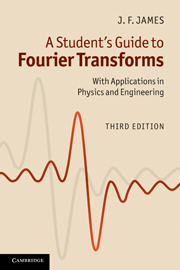Book contents
- Frontmatter
- Contents
- Preface to the first edition
- Preface to the second edition
- Preface to the third edition
- 1 Physics and Fourier transforms
- 2 Useful properties and theorems
- 3 Applications 1: Fraunhofer diffraction
- 4 Applications 2: signal analysis and communication theory
- 5 Applications 3: interference spectroscopy and spectral line shapes
- 6 Two-dimensional Fourier transforms
- 7 Multi-dimensional Fourier transforms
- 8 The formal complex Fourier transform
- 9 Discrete and digital Fourier transforms
- Appendix
- Bibliography
- Index
3 - Applications 1: Fraunhofer diffraction
Published online by Cambridge University Press: 05 June 2012
- Frontmatter
- Contents
- Preface to the first edition
- Preface to the second edition
- Preface to the third edition
- 1 Physics and Fourier transforms
- 2 Useful properties and theorems
- 3 Applications 1: Fraunhofer diffraction
- 4 Applications 2: signal analysis and communication theory
- 5 Applications 3: interference spectroscopy and spectral line shapes
- 6 Two-dimensional Fourier transforms
- 7 Multi-dimensional Fourier transforms
- 8 The formal complex Fourier transform
- 9 Discrete and digital Fourier transforms
- Appendix
- Bibliography
- Index
Summary
Fraunhofer diffraction
The application of Fourier theory to Fraunhofer diffraction problems, and to interference phenomena generally, was hardly recognized before the late 1950s. Consequently, only textbooks written since then mention the technique. Diffraction theory, of which interference is only a special case, derives from Huygens' principle: that every point on a wavefront which has come from a source can be regarded as a secondary source; and that all the wave fronts from all these secondary sources combine and interfere to form a new wavefront.
Some precision can be added by using calculus. In Fig. 3.1, suppose that at O there is a source of ‘strength’ q, defined by the fact that at A, a distance r from O, there is a ‘field’, E, of strength E = q/r. Huygens' principle is now as follows:
If we consider an area dS on the surface S we can regard it as a source of strength E dS giving at B, a distance r′ from A, a field E′ = q dS/(rr′). All these elementary fields at B, summed over the transparent part of the surface S, each with its proper phase, give the resultant field at B. This is quite general – and vague.
In elementary Fraunhofer diffraction theory we simplify. We assume the following.
That only two dimensions need be considered. All apertures bounding the transparent part of the surface S are rectangular and of length unity perpendicular to the plane of the diagram.
[…]
Information
- Type
- Chapter
- Information
- A Student's Guide to Fourier TransformsWith Applications in Physics and Engineering, pp. 40 - 65Publisher: Cambridge University PressPrint publication year: 2011
